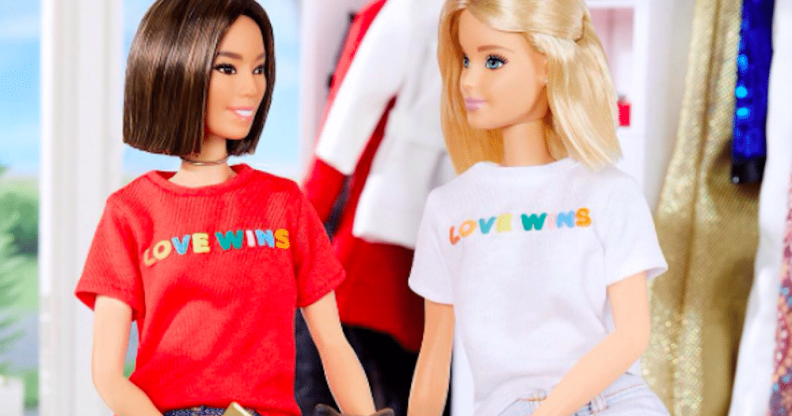No, Barbie does not have a girlfriend. But she is a proud LGBT+ ally

Barbie promoted the “love wins” T-shirts, designed to raise money for the Trevor Project and help LGBT+ youth in crisis. (Instagram/ BarbieStyle)
Despite a viral tweet making the rounds, unfortunately Barbie does not have a girlfriend and is not (as far as we know) a member of the LGBT+ community.
On Monday (11 January), a queer Twitter user posted that she had “JUST LEARNED BARBIE HAS A GIRLFRIEND”.
The tweet, which has been retweeted almost 15,000 times already, shows a photo of Barbie with another female doll, both wearing t-shirts that read “love wins”, alongside a Google result for a 2017 story claiming Mattel had given “Barbie her first girlfriend”.
Twitter users were ecstatic, with one writing: “Big win for everyone that made their Barbie dolls scissor when they were kids.”
Big win for Everyone that made their Barbie dolls scissor when they were kids
— cockroach queen (@gabagoolpentin) January 12, 2021
Another said: “Sapphic Barbie, this makes me really happy!!”
But unfortunately, Barbie never actually came out, and the second doll in the photo was never intended to be her girlfriend.
The VT article, misleadingly headlined “Barbie finally has a girlfriend and here’s what she looks like”, referred to a 2017 post on the Instagram account Barbie Style in collaboration with designer and fashion blogger Aimee Song.
Mattel created a doll for Song, as well as miniature versions of her “love wins” t-shirt, to promote the designer who was raising money for the Trevor Project to help LGBT+ youth in crisis.
The Instagram caption read: “Proud to wear this ‘Love Wins’ shirt with @songofstyle! Did you know that her exclusive t-shirts benefit different causes and non-profits?
“Such an inspiring initiative and fabulous few days I have spent with Aimee, she’s a doll!”
View this post on Instagram
Song released the t-shirt for Pride month, and explained on her blog that she is an “ally, and someone who really believes that love wins”.
Although Barbie might not be queer, in 2019 Mattel did release a line of gender-inclusive dolls “designed to keep labels out and invite everyone in”.
The Creatable World dolls come with short hair and a longer wig, as well as various items of clothing that include “masculine” and “feminine” options, so children can customise its gender expression with more than 100 combinations.
Monica Dreger, head of consumer insights at Mattel, told TIME Magazine at the time: “There were a couple of gender-creative kids who told us that they dreaded Christmas Day because they knew whatever they got under the Christmas tree, it wasn’t made for them.
“This is the first doll that you can find under the tree and see is for them because it can be for anyone.”

